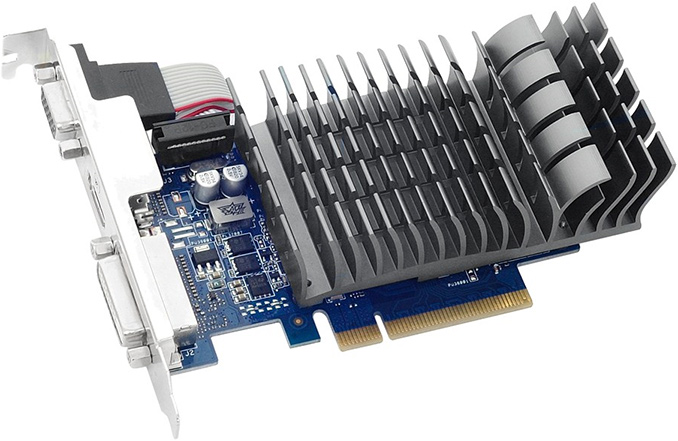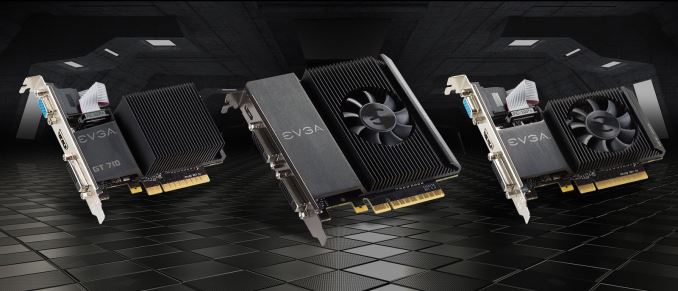NVIDIA’s Partners Roll-Out GeForce GT 710 to Fight Integrated Graphics
by Anton Shilov on January 27, 2016 1:07 PM EST
Advancements made by iGPUs by AMD and Intel in the recent years essentially destroyed the market of inexpensive discrete video cards. High-performance iGPUs can outperform low-end standalone graphics adapters these days and for a lot of users performance of integrated graphics is enough. Nonetheless, there's still a smaller market for low-end add-in boards - notably as upgrades to true entry-level PCs - and to that end NVIDIA’s partners this week released a new breed of low-end graphics cards targeting entry-level PCs.
The new NVIDIA GeForce GT 710 video cards are based on a cut-down version of the company's existing GK208 GPU, with 192 stream processors, 16 texture units and 8 ROPs. As this is a Kepler architecture product, you'll find baseline support for Direct3D feature level 11_0 but not newer features found in the Maxwell generation such as HDMI 2.0, which is likely why NVIDIA opted to launch this as a 700 series product. Peak compute performance of the GPU when clocked at 954 MHz is around 366 GFLOPS, which is below that of contemporary higher-end iGPUs by Intel or AMD. The GeForce GT 710 graphics cards are equipped with 1 or 2 GB or DDR3-1800 memory featuring 14.4 GB/s bandwidth.
| NVIDIA GPU Specification Comparison | ||||||
| GT 710 | GT 720 | GT 630 | GT 610 | |||
| CUDA Cores | 192 | 192 | 192 | 48 | ||
| Texture Units | 16 | 16 | 16 | 8 | ||
| ROPs | 8 | 8 | 16 | 4 | ||
| Core Clock | 954MHz | 797MHz | 875MHz | 710MHz | ||
| Shader Clock | N/A | N/A | N/A | 1620MHz | ||
| Memory Clock | 1.8GHz DDR3 | 1.8GHz DDR3/ 5GHz GDDR5 | 1.8GHz DDR3 | 1.8GHz DDR3 | ||
| Memory Bus Width | 64-bit | 64-bit | 64-bit | 64-bit | ||
| VRAM | 1GB or 2GB | 1GB or 2GB | 1GB or 2GB | 1GB | ||
| TDP | 19W | 19W | 50W | 29W | ||
| GPU | GK208 | GK208 | GK107 | GF119 | ||
| Launch Timeframe | January, 2016 | March, 2014 | April, 2012 | May, 2012 | ||
| Launch Price | $30 - $50 | $49 | OEM | $49 | ||
Makers of graphics cards position their NVIDIA GeForce GT 710 boards as solutions for entry-level PCs running Intel Celeron or Intel Pentium processors with mediocre iGPUs, and these are typically the comparisons you'llsee vendors make as it doesn't take much to surpass low-end iGPUs. That said, while the GeForce GT 710 can indeed be considerably faster than outdated integrated GPUs, it is unlikely that it can enable decent performance in demanding video games, and this is more likely to be pitched as a card for MOBAs and similar low-impact games.
From a sales perspective, since the GK208 GPU is not a new graphics chip - having been launched back in 2013 - it is somewhat surprising to see that virtually all partners of NVIDIA decided to release their new video cards powered by the GPU. The market for such adapters is very limited these days because 100% of entry-level PCs use iGPUs. Moreover, even in countries like China, where inexpensive hardware is sold in large quantities, more and more gamers are adopting higher-end discrete video cards, according to media reports.
Meanwhile from a technical perspective, as the GeForce GTX 710 are designed for low-end PCs, many of such video cards come in half-height/half-length form-factor. Typical for low-end cards (especially those expected to sell well in the APAC market), all of the GT 710s we've seen so far feature D-Sub analogue monitor output for compatibility with older monitors, along with the more typical DVI and/or HDMI/DP connectors. Meanwhile GT 710 is rated for a TDP of just 20 W, so many of the cards use passive cooling solutions, while the rest feature small fans.
The NVIDIA GeForce GT 710 graphics cards are available from companies like ASUS, EVGA, Galax, Gigabyte, Inno3D, Palit Multimedia, Manli, MSI, ZOTAC and some others. Prices of the GeForce GT 710-based graphics adapters vary, but typically such cards cost from $30 to $50 in the U.S.











60 Comments
View All Comments
yannigr2 - Thursday, January 28, 2016 - link
I think he stopped posting everywhere. One more indication that he was on a payroll. A temporary job. JMO.MrSpadge - Thursday, January 28, 2016 - link
If they made a new low end chip based on Maxwell they'd probably loose money on this, given these cards are probably extremly cheap for OEMs. And Maxwell would be of hardly any benefit to these using such cards: they don't really care about their GPU, otherwise they'd be using at least the GT720.10101010 - Wednesday, January 27, 2016 - link
Are all of these cards PCIe 2.0 x16? Seems like another niche market for low end discrete graphics would be DIY compute/deep learning systems that don't have processor/motherboard graphics, but do have an empty x1 or x4 PCIe slot.extide - Wednesday, January 27, 2016 - link
Sometimes cards like these are released as PCIe x1 cards -- of course this is just the OEM building it that way. I know Zotac has done this in the past.Mr Perfect - Thursday, January 28, 2016 - link
I guess you could always cut out the plastic on the end of the PCIe 1x slot and let the card hang off the end of it. The card should negotiate whatever link is available.yannigr2 - Wednesday, January 27, 2016 - link
On Nvidia low end cards, that memory clock means ABSOLUTELY NOTHING. It is ABSOLUTELY MISLEADING AND A LIE. Even many GT 710 models that where just announced, are coming with slower 1600MHz DDR3 and if you look in the market for example GT 610, you will have a hard time finding models with 1800MHz DDR3. Most come with memory with frequency from 1066MHz to 1400MHz. Looking also at how GT 720 is slower in the GPU, compared to GT 710, I don't expect GT 710 to keep that memory frequency for too long at 1600-1800MHz.MonkeyPaw - Wednesday, January 27, 2016 - link
I fail to see the point of this thing. It's not fast enough for games, so why would you add complexity to a system where the IGP is good enough? Sandy Bridge is about 5 years old now, and that iGPU can handle basic Windows.10101010 - Wednesday, January 27, 2016 - link
If it came in a PCIe x4 format, I might buy one for my compute box.For mainstream uses, I think many people forget that even a slow 2GB discrete video card is nice to have on a slower/memory-constrained system.
BrokenCrayons - Thursday, January 28, 2016 - link
It is hard to see much value in a card like this. The 64-bit DDR3 memory is going to inhibit performance for a 192 CUDA core part. However, for someone who might own a pre-Sandy Bridge system and want a little more graphics power without a lot of expense or worry over power supply upgrades and the like, this might not be a bad option. I personally wouldn't suggest anything less than a GT 730 with GDDR5 on a 64-bit interface for about 40 GB/s, but those sorts of cards retail for north of $60 which might be more than someone wants to spend on a graphics card.xthetenth - Thursday, January 28, 2016 - link
The only use I could see for it is as an adaptor card for running three monitors when the iGPU has awkward outputs.